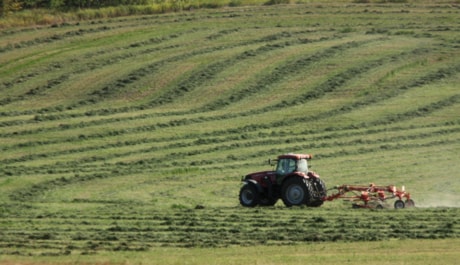The good news? Hay costs are lower than many feared a few months ago.
The bad news? Cow-calf operations are still a losing proposition.
Ted Nibourg, a farm business management specialist with Alberta Agriculture and Rural Development’s Ag-Info Centre in Stettler, says the severe hay shortage that some were predicting hasn’t materialized.
“The situation is definitely not as dire as what some of you media types originally set out to portray,” he said, referring to the spate of doom-and-gloom stories that emerged following the cold spring and subsequent drought.
“It scared the hell out of lot of people, and they panicked and maybe over-reacted,” he said, confirming that some hay did sell for “obscene” prices.
By July, however, rainfall had spurred hay growth and renewed pasture land. Later, extreme weather damaged some canola and grain crops, resulting in them being converted to green feed.
Another significant factor keeping hay prices in check was reduced demand.
Statistics Canada’s July 1 cattle inventory indicated a 9.5 per cent decline in Alberta’s beef cow herd, said Nibourg.
“The auction marts got so inundated they had to ration the amount of cows coming in.
“I think when we get our Jan. 1 numbers, we’re going to even see a more substantial decline in our cow numbers.”
Currently, hay for beef cattle is selling for between four and 4.5 cents a pound, said Nibourg. That’s far less than the $100-plus price per bale some were forecasting in June, but still exceeds the point where cow-calf producers can make a buck.
At 3.5 cents a pound, he said, a farmer would will lose about $20 an animal based on fall calf price projections. Bump that feed cost up to six cents a pound, and the loss swells to $80.
“These guys can’t afford to sell off their farm like that and remain in business. That’s why they’re pulling the pin.”
Doug Sawyer, a director and the finance chair with the Alberta Beef Producers, confirmed that many producers have sold their breeding stock or are talking about it. He hopes reduced cow numbers will bring some relief to the farmers who remain.
“The old supply and demand thing will kick in, hopefully.”
Unfortunately, said Nibourg, the strong loonie could prevent this.
“As the dollar goes up, our prices come down.”
Sawyer acknowledged that the dollar is a “huge factor,” and a weak market for fat cattle isn’t helping demand for calves.
“It doesn’t look very optimistic for this fall run, to me.”
The fact also remains that hay yields were down this year. And cow-calf operators like Sawyer, who farms near Pine Lake, must still feed their young animals.
“I’ve either got to take my calves somewhere to be custom-fed, in a feedlot, or sell them, because I simply don’t have any hay to feed them.”
By rights, said Sawyer, he should get out now. But he’s hopeful better times lie ahead, and after 25 years doesn’t want to leave the industry.
“My farming enterprise — I keep telling everybody — is a lifestyle, not a business arrangement.”
hrichards@www.reddeeradvocate.com
